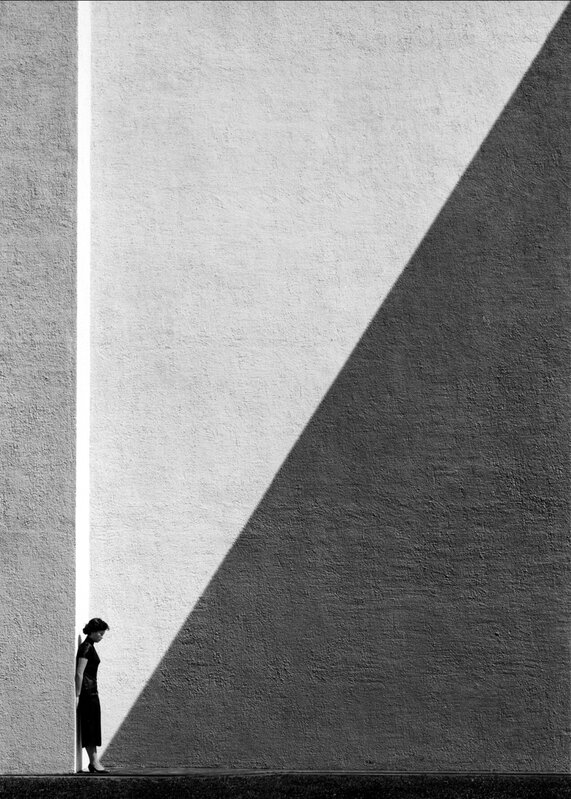My Artist: Fan Ho
Fan Ho: Style Analysis
Fan Ho’s work is often defined by its striking use of light and shadow, and his mastery in capturing the interplay between these elements is one of the most evocative aspects of his photography. Much like other street photographers of his era, Ho had an exceptional ability to use shadows not just as a background or filler but as a central visual and emotional tool. It was his masterly handling of light that was at work, especially in the dynamic cityscapes of the 1950s and 1960s in Hong Kong, which could elevate him into atmospheric, almost film-like compositions from the most unassuming of street scenes.
What sets Fan Ho apart is using shadows to invoke mood, narrative, and mystery. Very often, he resorted to sharp contrasts with dark shadows appearing to engulf or frame his subjects, hence giving drama to the scenes. His shadows often stretch across the frame and are almost another character in the composition, adding depth and complexity to what could be a simple street photograph. His silhouetted images, created either by heavy backlighting or by placing the subject in relation to the light source, give his images a sense of intrigue, even timelessness.
Photo Critique: “Approaching Shadow” (1950s-1960s)

In one of the classic photographs titled Approaching Shadow by Fan Ho, there is a lone figure moving down the street-thin, narrow-down the middle, bathed in strong light from a nearby window. The subject’s shadowy figure is dramatically stretched down the cobblestone ground. A background of shadows fills the frame with intricate, angular patterns that evoke tension and movement within it. But while still, the shadows would have seemed to ‘advance’ upon the subject, and an element of emotional suspense is created-as if the street itself had come alive, pulling the figure deeper into the scene.
The light and dark are sharply in contrast to each other, having impressive and powerful strength in this photo, while a figure in the foreground gets wrapped by the playing shadow. Ho uses the encroaching shadow to insinuate themes of alienation, the passing of time, and even change, perhaps, while the figure navigates through an environment that is both inviting and forbidding. Subtle yet palpable, this captures the sense of movement-the light and shadow in a dance, it would appear, with the subject sandwiched between them.
Connection with the Hutong Project:
Approaching Shadow by Fan Ho can be considered the ultimate reference for capturing Hutongs’ essence in Beijing, as through this photograph, one sees how shadows can create both a visual and emotional narrative within a street scene. The narrow alleys in Hutongs-much like the streets of Hong Kong during the time of Fan Ho-offer the ultimate playground to experiment with light and shadow. High walls and seldom any direct sunlight create alleys of deep contrasts of light through the gaps or windows and stretched shadows across the scene.
In the Hutongs, the shadows become major components of telling the story I want to tell. Like Ho, I will speak to the way in which shadows carve the character of the space: imposing building shadows, gentle clothesline drying, or lengthening human shades shifting through the roadways. Light and dark can create an atmosphere of mystery, intimacy, or even nostalgia so important to the way I want to capture the essence of Hutong. Mostly, I am interested in the use of Ho where there is a lot of shading to add complexity and drama. I would like to see if the shadows could reach out for the subjects of my photos and actively engage in the composition themselves. Much as with Fan Ho’s work, where at times the shadows seem to swallow up or pursue his subjects, I will be shooting to make images where the shadows appear to interact with the people of the Hutong-either a shadow reaching toward a person sitting in front of a doorway or the long evening shadows that creep along the cobblestone streets. These moments will add the sense of timelessness; the physicality of the street gets to meet the human experience.
That is where the work of Fan Ho comes in. It is really amazing to see how he depicts a quiet, atmospheric quality in a place and still subtly infuses it with narrative. Using the relation between light and shadow will expose the unseen drama and beauty of these historic alleys; it will be both about architecture and about the lives of people inhabiting them.
Leave a Reply
You must be logged in to post a comment.